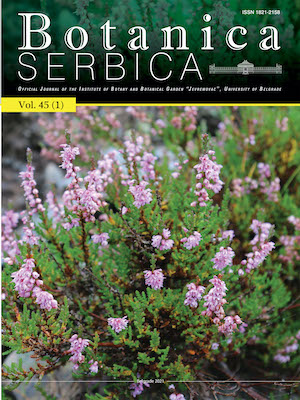
Volume 45 Issue 1 2021 |
The role of epigenetic modifications in plant responses to stress
|
KEY WORDS: DNA methylation, environmental stress, epigenetics, histone acetylation, non-coding RNAs |
A new species of Centaurea L. subgen. Cyanus Mill. (Asteraceae) from Turkey
|
KEY WORDS: achene, Compositae, Centaureinae, Cyanus, karyology |
Anatomical traits of Artemisia umbelliformis subsp. eriantha (Asteraceae) alpine glacial relict from Mt. Durmitor (Montenegro)
|
KEY WORDS: anatomy, crystals, secretory canals |
The toxic metal stress in two mosses of different growth forms under axenic and controlled conditions
|
KEY WORDS: Hypnum cupressiforme, Atrichum undulatum, zinc, copper, cadmium, in vitro |
The phytochemical composition and biological activities of different types of extracts of Achillea ageratifolia subsp. serbica
|
KEY WORDS: antimicrobial activity, antibiofilm activity, antioxidant activity, phenols, flavonoids, Asteraceae |
Differences in proline accumulation between wheat varieties in response to heat stress
|
KEY WORDS: Triticum aestivum, amino acid, photosynthetic pigments, adaptation, starch |
A biochemical and proteomic approach to the analysis of tomato mutant fruit growth
|
KEY WORDS: ABA, cell wall peroxidase, flacca mutant |
Alterations in the root proteomes of Brassica napus cultivars under salt stress
|
KEY WORDS: Brassica napus, germination, proteomics, salt tolerance |
Estimation of arsenic-induced genotoxicity in melon (Cucumis melo) by using RAPD-PCR and comet assays
|
KEY WORDS: DNA damage, genomic stability, genotoxicity tests, heavy metal stress |
The wild raspberry in Serbia: an ethnobotanical study
|
|
New records and noteworthy data of plants, algae and fungi in SE Europe and adjacent regions, 3
|
KEY WORDS: new report, Aegilops triuncialis, Antherospora hortensis, Chara canescens, Epipactis purpurata, Galanthus elwesii, Grimmia caespiticia, Loweomyces fractipes, Pholiota henningsii, Rhodobryum ontariense, Typha shuttleworthii, Umbilicus luteus, Woodsia alpina |
New records and noteworthy data of plants, algae and fungi in SE Europe and adjacent regions, 4
|
KEY WORDS: new report, Anthracoidea arenariae, Calluna vulgaris, Epipactis helleborine subsp. orbicularis, Equisetum hyemale, Fissidens exilis, Harpanthus flotovianus, Himantoglossum calcaratum subsp. rumelicum, Mahonia aquifolium, Rhizomnium punctatum, Schoenus nigricans, Stauroneis neofossilis, Willemetia stipitata subsp. albanica, SE Europe |
The chemical composition and anti-inflammatory effect of the essential oil obtained from Abeliophyllum distichum flowers
|
KEY WORDS: Abeliophyllum distichum, anti-inflammation, essential oil, pro-inflammatory mediator |
A contribution to Amanita alseides, a recently described European species in the section Vaginatae
|
KEY WORDS: Amanitaceae, Amanitopsis, Balkan mycota, biogeography, taxonomy |
In memoriam: Prof. Dr. Slobodan Jovanović (1955-2021)
|
List of reviewers for Botanica Serbica in 2020 — Acknowledgements
|


